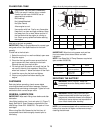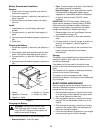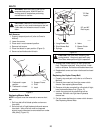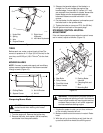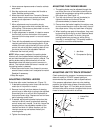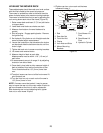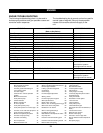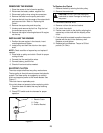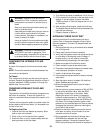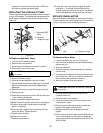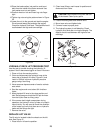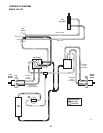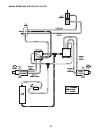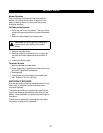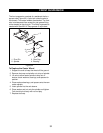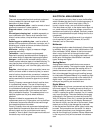
26
CHECKING THE HYDRAULIC FLUID
LEVEL
A check of the hydraulic fluid level should be made
daily.
NOTE: The oil level should be centered between the
two marks on the dipstick.
To Check:
First, remove any dirt that may be around the cap on
the tank. Remove the dipstick and check the oil level. If
required, add Mobil 15W50 synthetic oil through the
dipstick tube. Do not overfill.
CHANGING HYDRAULIC FLUID AND
FILTER
The hydraulic fluid and filter should be changed every
500 hours of operation. To drain the hydraulic oil
reservoir, remove the filter and catch the hydraulic oil in
a pan.
The filter for the hydraulic system is located under the
chassis behind the left rear wheel. It is accessed from
the rear of the unit.
To Replace the Filter
1. Unscrew the filter and dispose of properly. Allow
tank to drain into container.
2. Place a film of oil on the new filter’s gasket.
3. Screw the filter on until it makes contact with the
sealing surface of the filter head.
4. Turn the filter by hand, an additional 1/2 to 3/4 turn.
5. Fill the hydraulic oil reservoir to the top mark on the
dipstick. It will take about 5 quarts. Use Mobil
15W50 synthetic oil. Start the engine and run for 1
to 2 minutes.
6. After shutting off the engine, check the fluid level.
The dipstick should read the fluid level between the
high and low markings.
7. Properly dispose of waste oil.
HYDRAULIC DRIVE FLOW TEST
Use this procedure for trouble shooting the drive
system if the unit becomes sluggish or loss of drive
becomes apparent. This test is to be performed one
side at a time.
1. Block and jack the unit up so that both drive wheels
are off the ground.
2. Place hood into the full service position.
3. Verify that the bypass valves are closed and there
is no binding in the steering control linkage. If
binding occurs, you will need to correct that
problem before proceeding to the next steps.
4. Make sure hydraulic fluid level is correct.
5. Clean hydraulic hoses at the wheel motor.
6. Disconnect the hydraulic hoses at the wheel motor,
note the proper orientation of hoses.
7. Install a bi-directional flow gauge.
8. Have someone depress center of seat to activate
seat switch.
9. Start the engine and run at about 3/4 throttle or
faster. Release parking brake.
10.Stroke the appropriate control lever full stroke
forward and hold.
11.Set the hydraulic system pressure to 200-400 PSI
by using the restriction valve. Note the GPM
(gallon per minute) flow on the meter. While
keeping the pump in full stroke, increase the
hydraulic system pressure to 1000-1200 PSI by
using the restriction valve. Note the GPM flow on
the meter. Do not keep hydraulic system under
pressure for an extended period of time to prevent
damaging the hydraulic system by inducing too
much heat to the system.
12.Open the restriction valve and move the control
lever back to neutral. Idle unit down for a few
seconds and shut off engine.
13.The acceptable flow drop would be less than 1
GPM difference between the low and high
pressure settings. If flow drop is greater than 1
GPM, the hydro-pump will need to be repaired or
DRIVE TRAIN
WARNING: Hydraulic Fluid can result in
severe burns. Fluid in hydraulic system can
penetrate skin and result in serious injury or
death.
Be sure to stop the engine before doing any
work on hydraulic parts.
Keep body and hands away from pin holes or
nozzles which expel hydraulic fluid when
under pressure. Use paper or cardboard, not
hands, to search for leaks.
Insure all hydraulic fluid connections are tight
and all hydraulic hoses and lines are in good
condition before applying pressure to system.
WARNING: FOREIGN FLUID INJECTED
INTO BODY can result in gangrene. Fluid
must be surgically removed within a few hours
by a doctor familiar with this form of injury.



